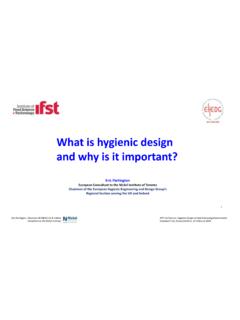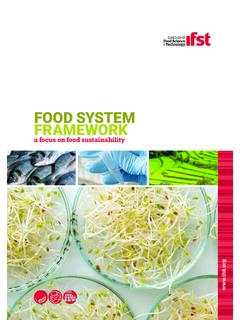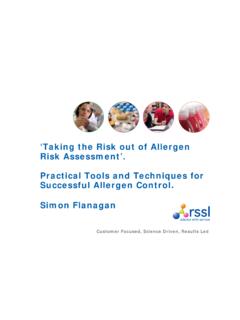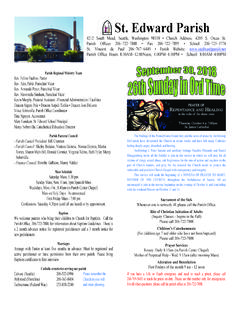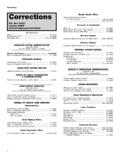Transcription of Using, Training and Implementing PAS 96:2014 - IFST
1 using , Training and Implementing PAS 96:2014 Professor tony hines , MBE, FIFST, Director of Crisis Management, Leatherhead Food Research 2 Key Points and using PAS 96:2014 HACCP used and accepted globally as a system to prevent accidental contamination of food. HACCP not generally used to detect or mitigate deliberate contamination or fraud. Deliberate contamination requires human intervention. The purpose of PAS96:2014 is to guide food businesses managers through approaches and procedures to improve the resilience of supply chains to fraud or other forms of attack. 3 Thinking Like Criminals PAS 96:2014 = HACCP + TACCP PAS 96:2014 describes Threat Assessment Critical Control Point (TACCP) which aligns with HACCP but has a different focus. This focus is PEOPLE and therefore needs the inputs from non-food safety specialists, especially HR. TACCP takes a business into the mind set of an attacker, anticipating their motivation & capability 4 PAS 96:2014 Implementing and using PAS My tool kit for:- Training Appreciation Risk Assessing Due Diligence To ensure:- Compliance that is: Reasonable and proportionate 5 In Food Defence we talk about Threats TACCP Threat Assessment Critical Control Point To ensure a safe and robust supply chain consider: Temptation Assessment Critical Control Point Identify where in the value chain there is a temptation for fraudulent activity, where most value can be added, what the benefits are and the potential for detection.
2 Consider Economic Temptation TACCP in Crisis Management 6 PAS 96: 2014 Broad Guidelines Intentionally non-specific Every business is different Does not seek to aid criminals Proportionality Risk is different for different businesses and product categories Differing Risk Assessments will lead to different action plans Assessments may conclude 'no action required' THINKING LIKE CRIMINALS 7 Stop being a Food Technologist / Safety Specialist, Quality Manager, Supply Chain Specialist and Think like a criminal What do you buy a lot of and could be subject to bulking or diluting to a degree that will not impact on the safety, sensory qualities of the product, not change it visually or physically, is expensive and untested? Temptation Assessment 8 Threat and Temptation TACCP The size of threat depends on key features: Motivation and capability of an attacker or group Vulnerability of the target Impact Assessment Intentional contamination requires human intervention 9 The factors, which comprise the three points of the so-called fraud triangle, are: A perceived pressure facing the person / business A perceived opportunity to commit fraud The business / person(s) integrity Opportunity Availability Quality Detection Profit The Fraud Triangle Pressure Opportunity Integrity 10 Food as a vehicle for Terrorist Acts In 1984, members of a religious sect contaminated salad bars in the USA with Salmonlla typhimurium causing 751 cases of salmonellosis.
3 The attack appeared to be a trial run for a more extensive attack intended to disrupt local elections 11 Worst case Biological agents (bacteria, toxins, viruses, parasites, etc.) can be delivered in the form of liquids, aerosols, or solids Chemical agents can be delivered as airborne droplets (nerve, blister, blood, and choking agents) and toxic chemicals ( , pesticides, rodenticides, lubricants, cleaning chemicals and heavy metals) Battlefield Chemical Weapons! Radioactive agents are radioactive elements that can be delivered in liquid or solid form Physical agents are materials that could cause adverse health effects if eaten ( bone slivers, glass fragments, and metal filings) 12 Threats and Threat Levels PAS identifies three generic threats: with toxic material of the supply chain for terrorist or criminal activity. Threats could be carried out by individuals or groups with no connection to the organisation, no contractual relationships or by alienated or disaffected staff MAD, BAD and SAD Business Response Levels (Threat Levels): Normal Heightened Exceptional 13 PAS 96: 2014 Makes the assumption that Managers are aware of: HACCP or Similar Risk Management Procedures Crisis Management Business Continuity Management 14 PAS 96: 2014 Recommends a team approach and integration into existing protocols.
4 Not an external audit tool but suppliers are likely (increasingly so) to ask if you are familiar with PAS 96:2014 Provides a framework of guidance Should be practical and proportionate Help businesses deter potential attackers. 15 What are we Defending? Raw Materials, Ingredients, Finished Products, Customers, Staff and Consumers Assets Equipment, Building, Vehicles, People Employees, Visitors, Contractors, Brand How much is this worth? 16 Building the TACCP Team Food Defense Coordinator (Security) Factory / Plant / Facility Manager Human Resources Manager Production Manager Quality Manager Manager Front Line Employees, loyal, long serving CEO / Director / Company Secretary 17 Food Defence Teams Who are the critical people that should be on the Food Defense Team or FDT ? Why is the team approach better than the individual approach? What should the requirements be for being a member of the team?
5 What are the responsibility of team members / deputies? Why are signed Non-Disclosure Agreements or Confidentiality Agreements imperative to be on the team? How to assess and evaluate the progress of the team? 18 Who are we Protecting from? Rogue or disgruntled employees Terrorists, ideologically motivated individuals or Groups Criminals and fraudsters Protesters - Anti-capitalist demonstrators Subversives, radicals, saboteurs Pressure Groups, ALF, WI PEOPLE 19 Information Harvesting on your Supply Chain Map / Document your supply chain Raw Materials inputs Ingredient inputs Products and Packaging Identify and prioritise vulnerabilities for food fraud What, Where, How, Who Food Fraud Vulnerability Assessments 20 Can be used for full page image/table if really, really required delete this text box HorizonScanRisk Framework Matrix tony hines , Leatherhead Food Research 2014 Continuously monitoring for change= Product Categoryof low level concern= Product Category potential concernsNew Product.
6 New market / supply chain without historicconfidence or relationship withsupplierLikelihood Store Cupboard commodity or ingredientProduct Commodity / Category SeverityKey Brand commodity or ingredient in multipleProducts of high valueMultiple Integrity / Reported ConcernsLittle or no current reporting or no reporting for five years plusSome evidence of increasedtrending on reported product integrity issuesHigh level of both historic and current reporting with five times trending Reporting from 22 Horizon Scan & Contaminants On-line Science and Software! 23 Leatherhead Food Research Professor tony hines MBE, FIFST Director of Crisis Management Leatherhead Food Research Randalls Road Leatherhead Surrey KT22 7RY. UK + 44 (0)1372 822245 mobile + 44 (0) 7778 474855


